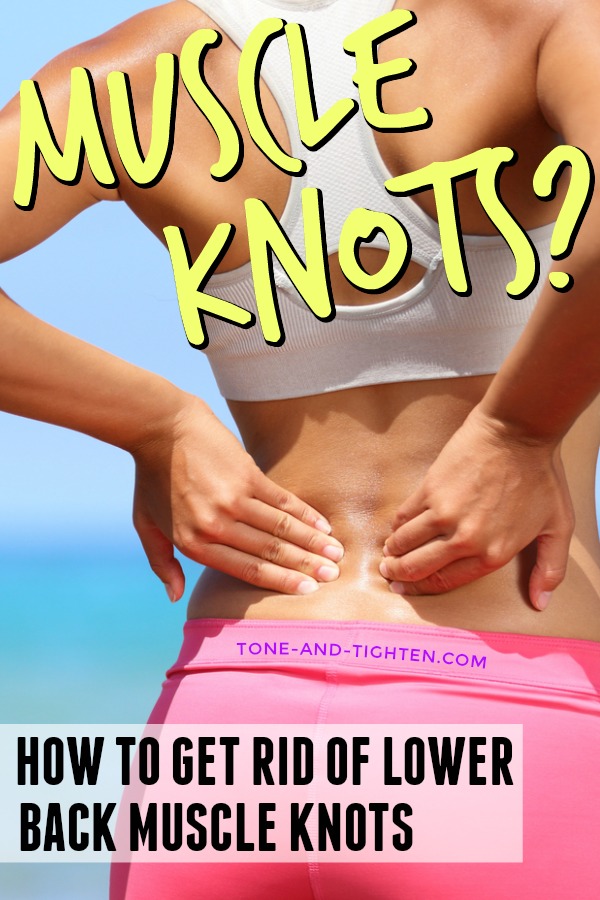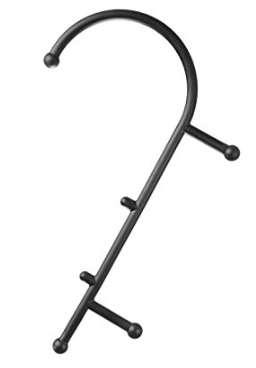What are muscle knots in your lower back? How do you get muscle knots in your lower back? What are the best ways to relieve muscle knots in your lower back?
As a doctor of physical therapy, these are questions that I answer all day long. Today I wanted to share with you 10 things you can do right now at home to eliminate muscle knots in your lower back. Let’s get it started!

How To Get Rid Of Muscle Knots In Your Lower Back
- Heat – facilitates blood flow and causes knot to “release”.
- Stretching – promotes elongation and tissue relaxation in knotted areas.
- Exercise – actively contracting and relaxing tight muscle fibers is great way to get them to “reset”.
- Massage – promotes blood flow and relaxation.
- Trigger Point Therapy – helps muscle knot to “release and reset”.
- Postural Corrections – treat the cause of the pain, not just the symptoms.
Keep reading below for detailed descriptions and video demonstrations of each of these points.
=========================================
7 Days of awesome at-home workouts and delicious dinner recipes – delivered daily right to your inbox!
Sign up for our all-new “7-Day Home Workout and Recipe Plan” by clicking RIGHT HERE!
=========================================
WHAT ARE MUSCLE KNOTS?
Muscle knots are hard, sensitive areas in our muscles where the muscle is in a shortened, contracted state even when the muscle is supposed to be at rest.
These muscle knots are commonly found in our neck and shoulders, lower back, and hips and are a common condition that affect millions of people everyday.
In physical therapy we often refer to these tight areas of contracted muscle as “trigger points” as oftentimes touching these areas can “trigger” pain in different location in your body.
Muscle knots can cause a painful, aching sensation in the muscle that can refer to nearby joints as well. When you touch it it feels tight and contracted despite your efforts to relax that area.
Muscle knots can also feel swollen and inflamed and can contribute to other associated problems including headaches, stress, anxiety, and difficulty sleeping.
Muscle knots are a common condition that I see in patients in my physical therapy clinic all the time. Fortunately there’s a lot that you can do about them to treat them safely and effectively right at home!
Today I wanted to share some of my favorite tips, tricks, and exercises to help you get rid of muscle knots in your lower back and hips. I’ve also included video demonstration of each of these methods to ensure you do them correctly and maximize your outcomes.
WHY DO YOU GET MUSCLE KNOTS?
Muscle knots are most often caused by:
- Muscle weakness
- Sedentary lifestyle/Lack of activity
- Poor posture
Other contributing factors can include stress/anxiety, unhealthy eating habits, and dehydration. For the purposes of this post, let’s briefly discuss these three common causes in more detail:
Muscle Weakness: Who among us couldn’t use a little more core strengthening? Weaker muscles are more susceptible to getting “stuck” in a painful, shortened position than strong, healthy muscles. This makes weak muscles are prone to developing knots, especially when combined with poor posture and a sedentary lifestyle.
Sedentary Lifestyle / Lack of Activity: When you get adequate, regular activity your muscles contract and relax normally. When we are sedentary and our muscles don’t contract and relax regularly this can predispose us to developing irregular muscle knots.
Poor posture: Let’s face it – we spend a lot of time sitting. Bending 90 degrees at our hips and then staying there for an extended period of time can cause an adaptive shortening of our hip flexors which, when we stand up, cause excessive strain on our lower backs. This can then turn into a source for our muscle tightness and knots in our lower back.
HOW TO TREAT MUSCLE KNOTS
Keep in mind that treating your muscle knots can take some time. You didn’t develop them overnight; chances are they’re not going to go away overnight, also.
To treat your muscle knots you’ll need to focus on two things: “breaking up” the knotted tissue and calming down the inflamed nerves.
Below you’ll find a list of the most effective methods to alleviate your muscle knots at home.
Be sure to watch this video for demonstration and detailed instruction on each one of these interventions:
1. Heat: applying heat to an area causes capillaries to dilate, thereby promoting more blood flow into that area. Increasing blood flow to knotted muscle fibers can be an effective means of getting knots to release.
2. Stretching: as mentioned previously, muscle knots are areas of the muscle that fail to fully relax/elongate. Stretching the muscles in which these knots lie is an effective way to stretch out the knot, decrease tension, and decrease your pain.
My two go-to stretches for lower back knots are the “Child’s Pose” and “Piriformis” stretches. Be sure to watch the video above as to how these exercises are performed.
3. Exercise: the stronger your back, the decreased pain you’ll have overall. Period. So much of my day is spent demonstrating and recommending core exercises to people and the results really speak for themselves. Strengthening the muscles in your back will help to not only eliminate the muscle knots you have, but keep them from coming back as well.
Bridges and cat/cow are my go-to exercises for lower back muscle knots; demonstrated in the video above.
4. Trigger Point Therapy: It’s not uncommon to hear muscle knots referred to as “trigger points”. This nomenclature simply means pain in one area that manifests itself in another. Muscle knots (or trigger points) respond well to “trigger point therapy” or a “trigger point release”. This means you apply a pressure to the area of tight muscle fibers and then sustain that pressure until the knot “releases” or the fibers reset.
My go-to trigger point release techniques for the lower back are laying on tennis balls and/or self mobilization with a device such as a “Theracane”. Unsolicited plug – if you suffer from muscle knots these Theracanes are a necessity. They’re a convenient and easy way to administer self-massage and trigger point release to these areas and feel fantastic. Pick yours up by CLICKING ON THIS LINK.
5. Postural Corrections: It’s one thing to treat SYMPTOMS; it’s quite another to treat the actual CAUSE of your pain. Oftentimes the knots you feel in your lower back are a symptom of a bigger issue and oftentimes that bigger issue is poor posture.
For those of you who may sit extended periods of time, have a weak core, or even genetic predisposition – posture could be a contributing factor to your lower back muscle knots.
For a comprehensive video about lower back posture including why you get it, how it affects you, and other core exercises you can do to correct it, please CLICK ON THIS LINK to be taken to a video I did recently about this subject.
You do not have to suffer from muscle knots in your lower back! Regularly performing these stretches, exercises, and release techniques can effectively eliminate the knots from these areas and help you to feel better faster.
Looking for more great YouTube helps from Tone and Tighten? Here are a few of our most-popular videos:
Questions or comments for Jared? I would love to hear from you! Leave me a comment down below and I’ll answer just as soon as I can.
Make it happen,
Jared

